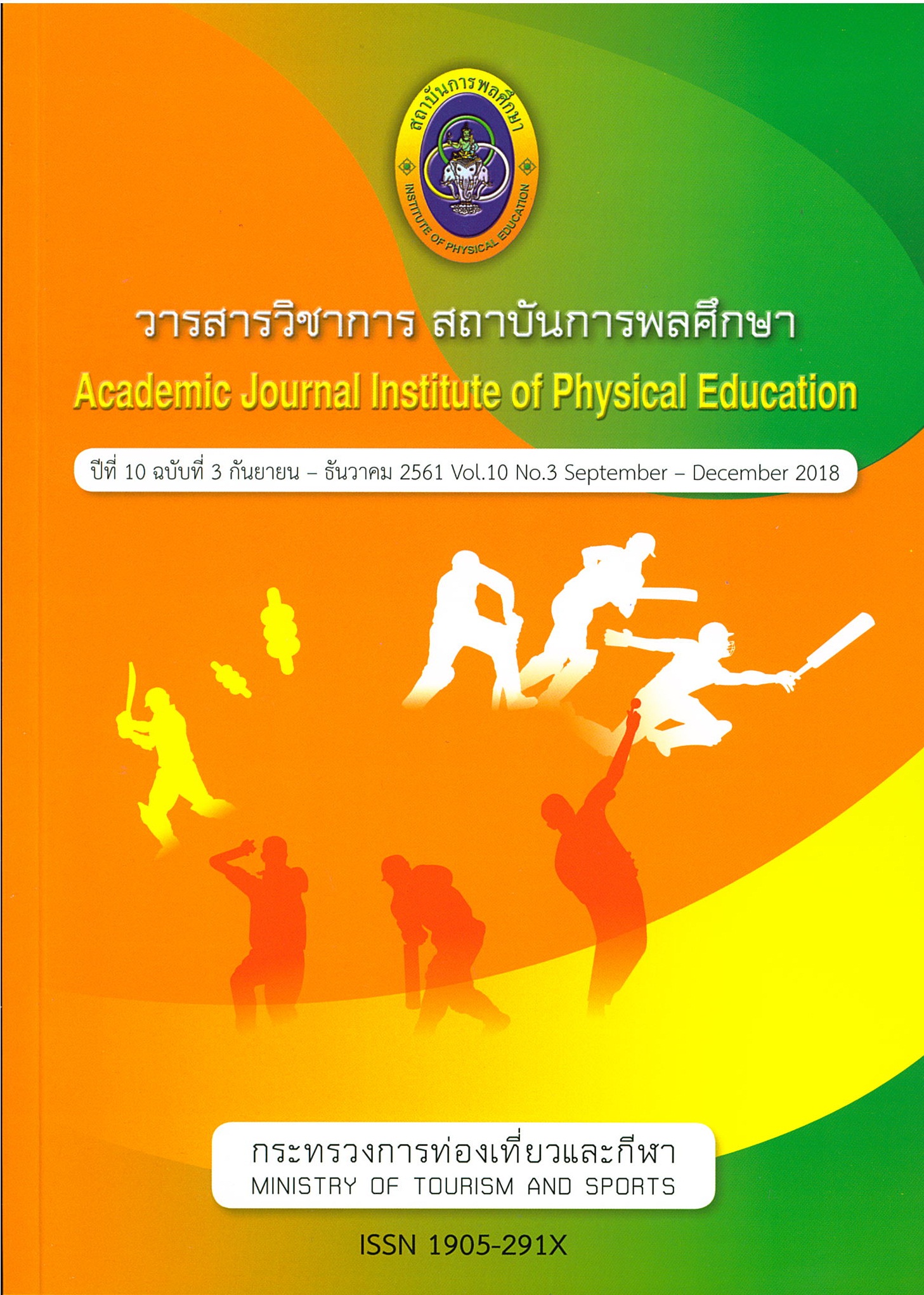Marketing conditions of Sports Competition Business in Chiang Mai
Main Article Content
Abstract
The purposesof this research were1) to study the strengths, weaknesses, opportunities and treats of sports competition business in Chiang Mai. 2) to study the marketing conditions of sports competition business in Chiang Mai 3) to study the marketing mix that influences the decision to utilize sports competition services in Chiang Mai. The research is qualitative and quantitative research. The research samples were those who involved in sports management business. The samples were used in 7 in-depth interviews, 7 subgroups, and 40 questionnaires. The instruments used in the research were interviews and questionnaires. The research was conducted by in-depth interviews. Specifically, and subgroup discussion. Analysis of data by in-depth interview by using the content analysis which got along with the collectionof data from the research objectives. The data were analyzed by frequency, percentage, mean, and standard deviation It was found that the market conditions of the sport management business in Chiang Mai provide more strengths than weaknesses and more opportunities than threats. Therefore,offensive business strategies can beemployed.Thesports competition business in Chiang Mai were found to be non-competitive. Most competitions have been organized by stadium owners or government agencies and participated by sports enthusiasts without any unique sporting events not identity of its province. The service users will have a lot of bargaining power, as sports event organizing business has aimed for organizing activities for the mass just to meet the objective and effectiveness of the event rather than profit. Entrant barriers for new comers are low, as no fixed assets investment is needed. Only skills and experiences in event management and alliances with related organizations are required. The owners of artificial turfs and golf courses imposed higher entrant barriers to new comers as much higher investment, fixed assets and land are required. The bargaining power of the raw material suppliers is low as sports event organizing business involve many
parties and their collaboration. The threat of replacement product is low as sports event organizing business demands knowledge and experience of organizers. Possible threats are from internal self-organized sport events without outsourcing. Marketing factors influencing decision making at a high level are firstly personnel, secondly distribution and product.
Article Details
The published article is a copyright of the Academic Journal of Thailand National Sports University. The passage appeared in each article in this academic journal is a perspective of each author which is not related to the journal. Each author is required to be responsible for all components of his/her own article. If there are any mistakes, each author must be responsible for those mistakes on his/her own.
References
การกีฬาแห่งประเทศไทย. (2560). แผนยุทธศาสตร์การกีฬาแห่งประเทศไทย (2560-2564). สืบค้นเมื่อ 25 มกราคม 2560, จาก http://www.senate.go.th/w3c/senate/pictures/comm/51/sport%20science/050.pdf.
ชัยสมพล ชาวประเสริฐ. (2546). การตลาดบริการ. กรุงเทพฯ: ซีเอ็ดยูเคชั่น.
ชูระวี สุริยจันทร์. (2556). การจัดการแข่งขันกีฬา. สถาบันการพลศึกษา. กรุงเทพฯ: นิบุญ จำกัด.
ธเนศ ยุคันตวนิชชัย. (2553). ขับเคลื่อนกีฬาด้วย “SPORTS MARKEING”. กรุงเทพฯ: 1688 มีเดีย.
ปณิศา ลัญชานนท์. (2548). หลักการตลาด. กรุงเทพฯ: ธรรมสาร.
ภูมิ เกตุคำ. (2558). ส่วนประสมทางการตลาดที่ผู้ใช้บริการเลือกใช้สนามกอล์ฟใน จังหวัดปทุมธานี. บริหารธุรกิจมหาบัณฑิต มหาวิทยาลัยปทุมธานี. ปทุมธานี: มหาวิทยาลัยปทุมธานี.
ยุทธนา ธรรมเจริญ. (2544). การวิเคราะห์พฤติกรมผู้บริโภค. นนทบุรี: มหาวิทยาลัยสุโขทัยธรรมาธิราช.
วิกรานต์ มงคลชาญ. (2556).การวิเคราะห์ตลาดด้วย BCG matrix.29 มิถุนายน 2559,http://marketingforexp.blogspot.com/2013/10/bcg-matrix.html.
วารุณี ตันติวงศ์วาณิช และคณะ. (2554). หลักการตลาด. กรุงเทพฯ: เพียร์สัน เอ็ดดูเคชั่น อินโดไซน่า.
สมชาติ กิจยรรยง. (2547). ยุทธวิธีบริการครองใจลูกค้า. กรุงเทพฯ: เอ็มไอทีคอนซัลติ้ง จำกัด.
สมนึก จันทรประทิน. (2544). การวิเคราะห์การแข่งขันในตลาด. นนทบุรี: มหาวิทยาลัยสุโขทัยธรรมาธิราช.
หนังสือพิมพ์มติชน. (2559). เปิดแผนปฏิรูปกีฬาปี 2560. สืบค้นเมื่อ 30 มิถุนายน 2559, จาก http://www.matichon.co.th/matichon/matichon.php.
เอกกมล เอี่ยมศรี. (2554). การวิเคราะห์ตลาดด้วย TOWS matrix. สืบค้นเมื่อ11 มิถุนายน 2559, จาก https://eiamsri.wordpress.com/2011/06/07/%E0%B8%81%E0%B8%B2%E0%B8%A3%E0%B9%83%E0%B8%8A%E0%B9%89-tows-matrix/.


